Unit 2 What time do you go to school?复习课件(共20张PPT)
文档属性
| 名称 | Unit 2 What time do you go to school?复习课件(共20张PPT) |  | |
| 格式 | zip | ||
| 文件大小 | 421.6KB | ||
| 资源类型 | 教案 | ||
| 版本资源 | 人教新目标(Go for it)版 | ||
| 科目 | 英语 | ||
| 更新时间 | 2022-08-09 12:13:40 | ||
图片预览

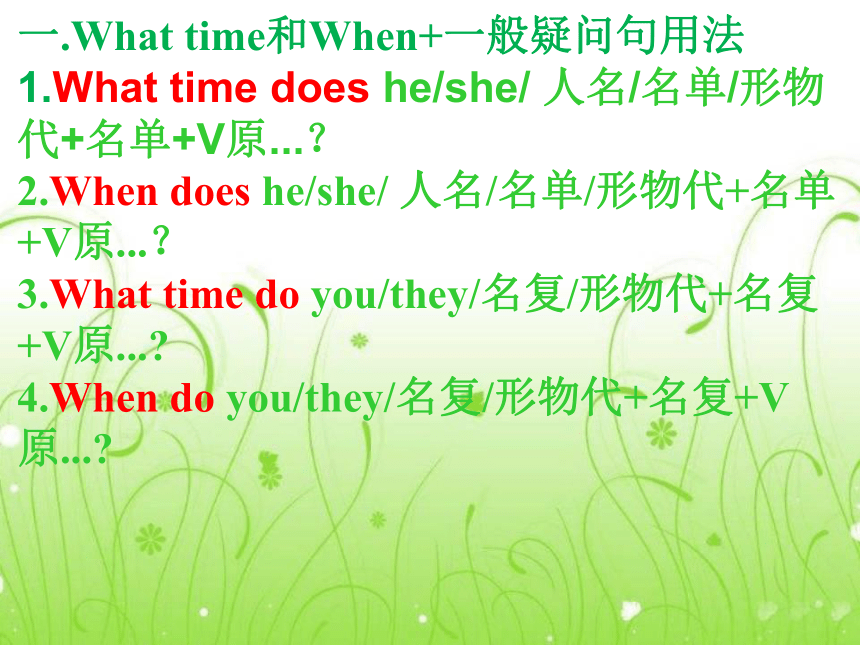

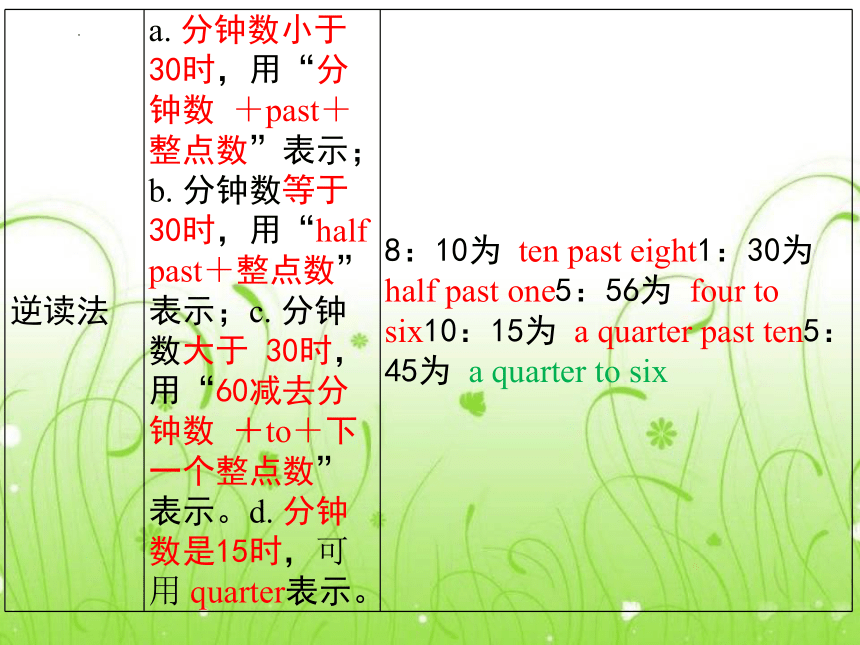
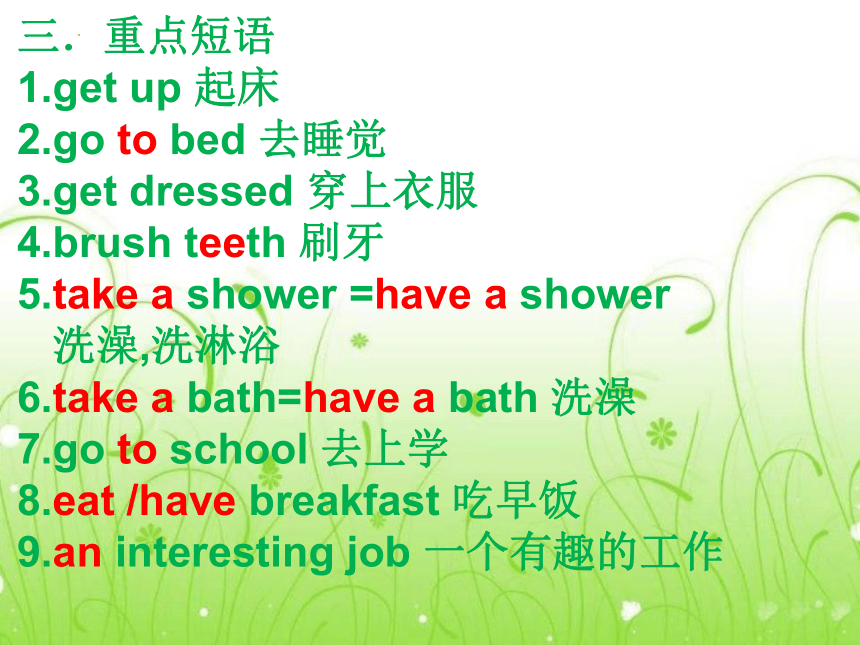
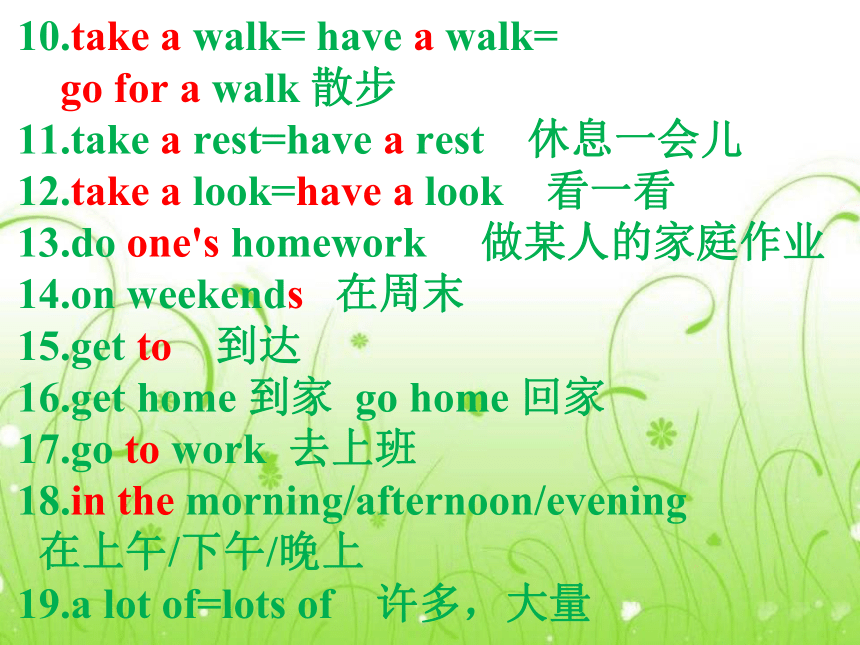
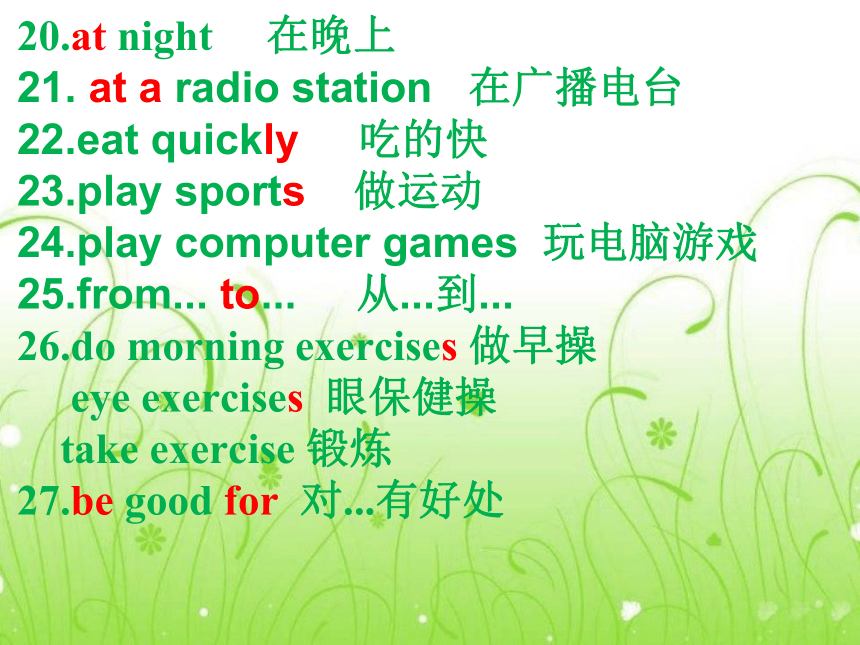
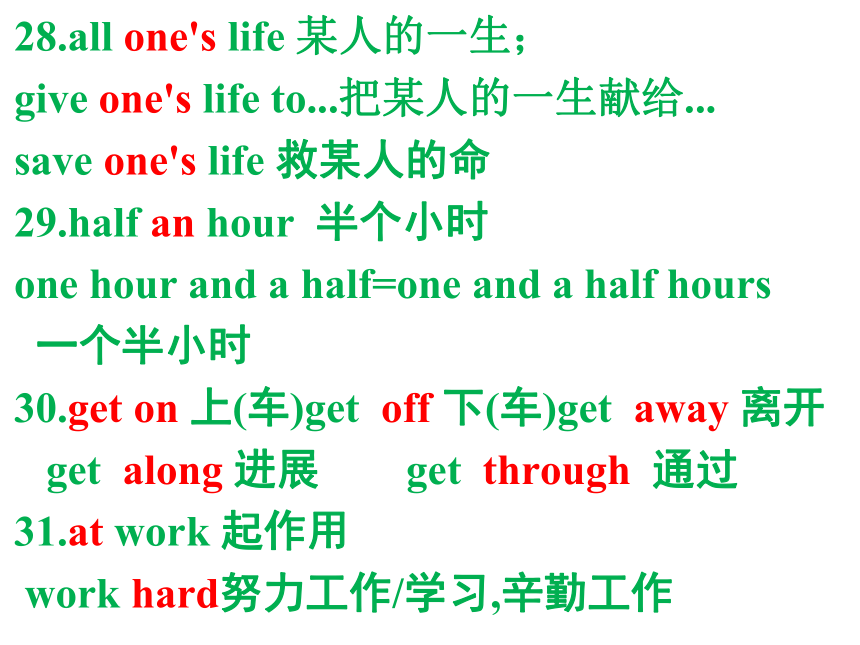
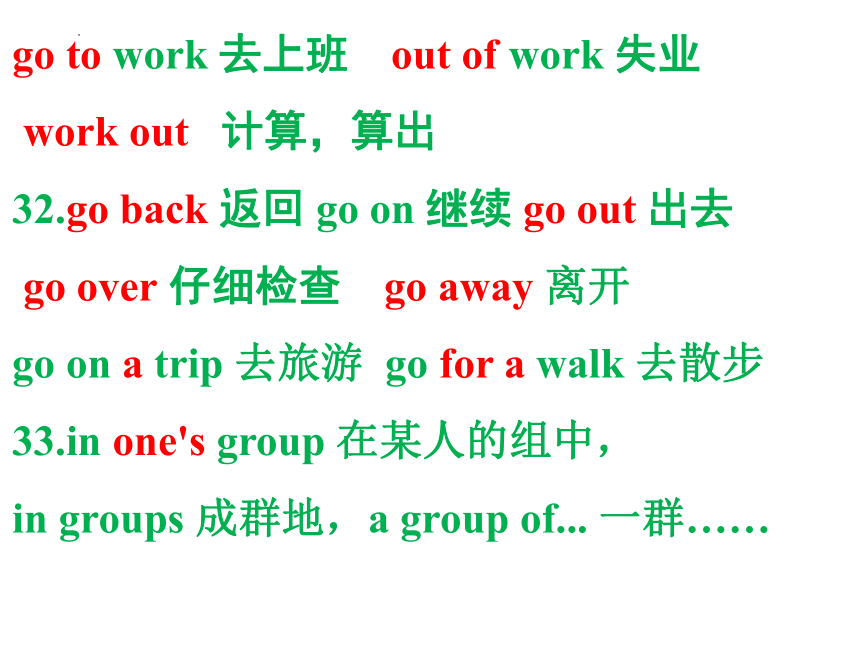
文档简介
(共20张PPT)
Unit 2 What time do you go to school?
单元复习
Come on!!!
Boys and Girls
一.What time和When+一般疑问句用法
1.What time does he/she/ 人名/名单/形物代+名单+V原...?
2.When does he/she/ 人名/名单/形物代+名单+V原...?
3.What time do you/they/名复/形物代+名复+V原...
4.When do you/they/名复/形物代+名复+V原...
二.时间的表达法
分类 用法 例子
整点法 时间为整点时,可用“整点数+o'clock”表示,o'clock也可省略。 It's five o'clock./It's five.现在5点(整)。
顺读法 “先时后分”,先读整点数,再读分钟数,都用基数词来读。当分钟数小于10 时,遇到数字0,发字母o的音 / /。 6:30为 six thirty 2:58为 two fifty- eight 4:05为 four o (/ /) five
逆读法 a. 分钟数小于 30时,用“分钟数 +past+整点数”表示;b. 分钟数等于 30时,用“half past+整点数”表示;c. 分钟数大于 30时,用“60减去分钟数 +to+下一个整点数”表示。d. 分钟数是15时,可用 quarter表示。 8:10为 ten past eight1:30为 half past one5:56为 four to six10:15为 a quarter past ten5:45为 a quarter to six
三.重点短语
1.get up 起床
2.go to bed 去睡觉
3.get dressed 穿上衣服
4.brush teeth 刷牙
5.take a shower =have a shower
洗澡,洗淋浴
6.take a bath=have a bath 洗澡
7.go to school 去上学
8.eat /have breakfast 吃早饭
9.an interesting job 一个有趣的工作
10.take a walk= have a walk=
go for a walk 散步
11.take a rest=have a rest 休息一会儿
12.take a look=have a look 看一看
13.do one's homework 做某人的家庭作业
14.on weekends 在周末
15.get to 到达
16.get home 到家 go home 回家
17.go to work 去上班
18.in the morning/afternoon/evening
在上午/下午/晚上
19.a lot of=lots of 许多,大量
20.at night 在晚上
21. at a radio station 在广播电台
22.eat quickly 吃的快
23.play sports 做运动
24.play computer games 玩电脑游戏
25.from... to... 从...到...
26.do morning exercises 做早操
eye exercises 眼保健操
take exercise 锻炼
27.be good for 对...有好处
28.all one's life 某人的一生;
give one's life to...把某人的一生献给...
save one's life 救某人的命
29.half an hour 半个小时
one hour and a half=one and a half hours
一个半小时
30.get on 上(车)get off 下(车)get away 离开
get along 进展 get through 通过
31.at work 起作用
work hard努力工作/学习,辛勤工作
go to work 去上班 out of work 失业
work out 计算,算出
32.go back 返回 go on 继续 go out 出去
go over 仔细检查 go away 离开
go on a trip 去旅游 go for a walk 去散步
33.in one's group 在某人的组中,
in groups 成群地,a group of... 一群……
34.take a seat 坐下;take away 拿走;
take photos 照相,拍照;
take out 拿出; take down 取下;
四.用法集萃
1.辨析what time 与when
1)what time 只用于询问具体的时间点,用
来对某个时间提问,希望知道的时间比
when 更具体。当询问某个具体时刻时,用
what time,当泛指“做某事的时间”时,
when 和what time一般可互换。
2)when 既可问时间点,也可问时间段,
常用于对日期(某年、某月、某日)提问。
2.get/be dressed in+ 衣服或表示颜色的词
3.dress+sb.(或oneself) 给……穿衣服
4.It's time for.../It's time to do...
到了该(做)……的时候了
5.It's time for sb. to do sth.
某人到了该做某事了的时候
6.be late for... ……迟到
7.exercise n.锻炼;运动(不可数) 训练活动;练习;习题(可数)
8.work 指生活中的各类工作,是不可数名词。
9.job 指具体的职业或工作,是可数名词。
10.常用频度副词有usually ( 通常),
sometimes ( 有时), always ( 总是), often ( 经
常), never ( 从不) ,这些词常位于系动词、
情态动词或助动词之后,实义动词之前.
11.辨析at, in与on
1)at 常用于具体钟点前或一些固定的习惯用语中。at five o'clock在五点钟
at noon/night 在中午/晚上at that time在那时
2)in 用在月份、季节、年份等前面,也可以表示在早上、在下午或在晚上。
in May 在五月 in spring 在春季
in 2016 在2016年 in the morning 在早上
3)on 用在日期、星期几、节日前,也用来
表示在具体某一天的上午、下午或晚上。
on Monday 在星期一
on Children's Day 在儿童节
on the afternoon of July 8th
在7月8日的下午
12.辨析sometimes, some times, sometime 与some time
1)some time 表示“一段时间”,可用于将来或过去时。
2)sometime 表示“某时”
3)some times 表示次数,“几次”
4)sometimes 表示“有时候”。相当于
at times
分开“一段”,连“某时”;
分开s 表“几次”,相连s 是“有时”。
13.辨析:
either...or...neither...nor...;both...and...;与
not only...but also...;
1) either...or... 表示:或者...或者...;谓语动词
运用就近原则(由or后面的主语决定);
Either she or I am right. 她和我有一个对的。
2)neither...nor... 表示:既不...也不...;谓语动
词运用就近原则(由nor后面的主语决定);
Neither you nor she is right. 你和她都不对。
3)both...and... 表示:两者都;谓语动词用复
数;
Both she and I are right. 她和我都对。
4)not only...but also... 表示:不仅...而且...;
连接两个主语时,谓语动词运用就近原则;
Not only she but also I am right.
不仅她而且我也是对。
14.辨析lots of, many与 much
1)lots of =a lot of 修饰可数名词复数和不可数名词
There are lots of people in the park.
公园里有许多人。
2)many 修饰可数名词复数
Do you have many books 你有很多书吗?
3)much 修饰不可数名词
I spend much time doing my homework every day.
我每天花大量的时间做家庭作业。
15.表示感觉的连系动词:有look“看起来”;
sound“听起来”;smell“闻起来;有……的气
味”;feel“摸起来”,taste尝起来 。
16.half past+小时 表示:几点半
17.Sb. +have/has a very +形容词+ life.也可表达为: “Sb. +live(s) a...life.”
He has a very healthy life. =
He lives a healthy life.
他过着非常健康的生活。
Now, in China, we are having a happy life.
现在,在中国,我们过着幸福的生活。
18.What’s the time now /What time is it?
It’s+点钟
19.after作为介词,其结构为:after+V-ing;
Unit 2 What time do you go to school?
单元复习
Come on!!!
Boys and Girls
一.What time和When+一般疑问句用法
1.What time does he/she/ 人名/名单/形物代+名单+V原...?
2.When does he/she/ 人名/名单/形物代+名单+V原...?
3.What time do you/they/名复/形物代+名复+V原...
4.When do you/they/名复/形物代+名复+V原...
二.时间的表达法
分类 用法 例子
整点法 时间为整点时,可用“整点数+o'clock”表示,o'clock也可省略。 It's five o'clock./It's five.现在5点(整)。
顺读法 “先时后分”,先读整点数,再读分钟数,都用基数词来读。当分钟数小于10 时,遇到数字0,发字母o的音 / /。 6:30为 six thirty 2:58为 two fifty- eight 4:05为 four o (/ /) five
逆读法 a. 分钟数小于 30时,用“分钟数 +past+整点数”表示;b. 分钟数等于 30时,用“half past+整点数”表示;c. 分钟数大于 30时,用“60减去分钟数 +to+下一个整点数”表示。d. 分钟数是15时,可用 quarter表示。 8:10为 ten past eight1:30为 half past one5:56为 four to six10:15为 a quarter past ten5:45为 a quarter to six
三.重点短语
1.get up 起床
2.go to bed 去睡觉
3.get dressed 穿上衣服
4.brush teeth 刷牙
5.take a shower =have a shower
洗澡,洗淋浴
6.take a bath=have a bath 洗澡
7.go to school 去上学
8.eat /have breakfast 吃早饭
9.an interesting job 一个有趣的工作
10.take a walk= have a walk=
go for a walk 散步
11.take a rest=have a rest 休息一会儿
12.take a look=have a look 看一看
13.do one's homework 做某人的家庭作业
14.on weekends 在周末
15.get to 到达
16.get home 到家 go home 回家
17.go to work 去上班
18.in the morning/afternoon/evening
在上午/下午/晚上
19.a lot of=lots of 许多,大量
20.at night 在晚上
21. at a radio station 在广播电台
22.eat quickly 吃的快
23.play sports 做运动
24.play computer games 玩电脑游戏
25.from... to... 从...到...
26.do morning exercises 做早操
eye exercises 眼保健操
take exercise 锻炼
27.be good for 对...有好处
28.all one's life 某人的一生;
give one's life to...把某人的一生献给...
save one's life 救某人的命
29.half an hour 半个小时
one hour and a half=one and a half hours
一个半小时
30.get on 上(车)get off 下(车)get away 离开
get along 进展 get through 通过
31.at work 起作用
work hard努力工作/学习,辛勤工作
go to work 去上班 out of work 失业
work out 计算,算出
32.go back 返回 go on 继续 go out 出去
go over 仔细检查 go away 离开
go on a trip 去旅游 go for a walk 去散步
33.in one's group 在某人的组中,
in groups 成群地,a group of... 一群……
34.take a seat 坐下;take away 拿走;
take photos 照相,拍照;
take out 拿出; take down 取下;
四.用法集萃
1.辨析what time 与when
1)what time 只用于询问具体的时间点,用
来对某个时间提问,希望知道的时间比
when 更具体。当询问某个具体时刻时,用
what time,当泛指“做某事的时间”时,
when 和what time一般可互换。
2)when 既可问时间点,也可问时间段,
常用于对日期(某年、某月、某日)提问。
2.get/be dressed in+ 衣服或表示颜色的词
3.dress+sb.(或oneself) 给……穿衣服
4.It's time for.../It's time to do...
到了该(做)……的时候了
5.It's time for sb. to do sth.
某人到了该做某事了的时候
6.be late for... ……迟到
7.exercise n.锻炼;运动(不可数) 训练活动;练习;习题(可数)
8.work 指生活中的各类工作,是不可数名词。
9.job 指具体的职业或工作,是可数名词。
10.常用频度副词有usually ( 通常),
sometimes ( 有时), always ( 总是), often ( 经
常), never ( 从不) ,这些词常位于系动词、
情态动词或助动词之后,实义动词之前.
11.辨析at, in与on
1)at 常用于具体钟点前或一些固定的习惯用语中。at five o'clock在五点钟
at noon/night 在中午/晚上at that time在那时
2)in 用在月份、季节、年份等前面,也可以表示在早上、在下午或在晚上。
in May 在五月 in spring 在春季
in 2016 在2016年 in the morning 在早上
3)on 用在日期、星期几、节日前,也用来
表示在具体某一天的上午、下午或晚上。
on Monday 在星期一
on Children's Day 在儿童节
on the afternoon of July 8th
在7月8日的下午
12.辨析sometimes, some times, sometime 与some time
1)some time 表示“一段时间”,可用于将来或过去时。
2)sometime 表示“某时”
3)some times 表示次数,“几次”
4)sometimes 表示“有时候”。相当于
at times
分开“一段”,连“某时”;
分开s 表“几次”,相连s 是“有时”。
13.辨析:
either...or...neither...nor...;both...and...;与
not only...but also...;
1) either...or... 表示:或者...或者...;谓语动词
运用就近原则(由or后面的主语决定);
Either she or I am right. 她和我有一个对的。
2)neither...nor... 表示:既不...也不...;谓语动
词运用就近原则(由nor后面的主语决定);
Neither you nor she is right. 你和她都不对。
3)both...and... 表示:两者都;谓语动词用复
数;
Both she and I are right. 她和我都对。
4)not only...but also... 表示:不仅...而且...;
连接两个主语时,谓语动词运用就近原则;
Not only she but also I am right.
不仅她而且我也是对。
14.辨析lots of, many与 much
1)lots of =a lot of 修饰可数名词复数和不可数名词
There are lots of people in the park.
公园里有许多人。
2)many 修饰可数名词复数
Do you have many books 你有很多书吗?
3)much 修饰不可数名词
I spend much time doing my homework every day.
我每天花大量的时间做家庭作业。
15.表示感觉的连系动词:有look“看起来”;
sound“听起来”;smell“闻起来;有……的气
味”;feel“摸起来”,taste尝起来 。
16.half past+小时 表示:几点半
17.Sb. +have/has a very +形容词+ life.也可表达为: “Sb. +live(s) a...life.”
He has a very healthy life. =
He lives a healthy life.
他过着非常健康的生活。
Now, in China, we are having a happy life.
现在,在中国,我们过着幸福的生活。
18.What’s the time now /What time is it?
It’s+点钟
19.after作为介词,其结构为:after+V-ing;
同课章节目录
- Unit 1 Can you play the guitar?
- Section A
- Section B
- Unit 2 What time do you go to school?
- Section A
- Section B
- Unit 3 How do you get to school?
- Section A
- Section B
- Unit 4 Don't eat in class.
- Section A
- Section B
- Unit 5 Why do you like pandas?
- Section A
- Section B
- Unit 6 I'm watching TV.
- Section A
- Section B
- Review of Units 1-6
- Unit 7 It's raining!
- Section A
- Section B
- Unit 8 Is there a post office near here?
- Section A
- Section B
- Unit 9 What does he look like?
- Section A
- Section B
- Unit 10 I'd like some noodles.
- Section A
- Section B
- Unit 11 How was your school trip?
- Section A
- Section B
- Unit 12 What did you do last weekend?
- Section A
- Section B
